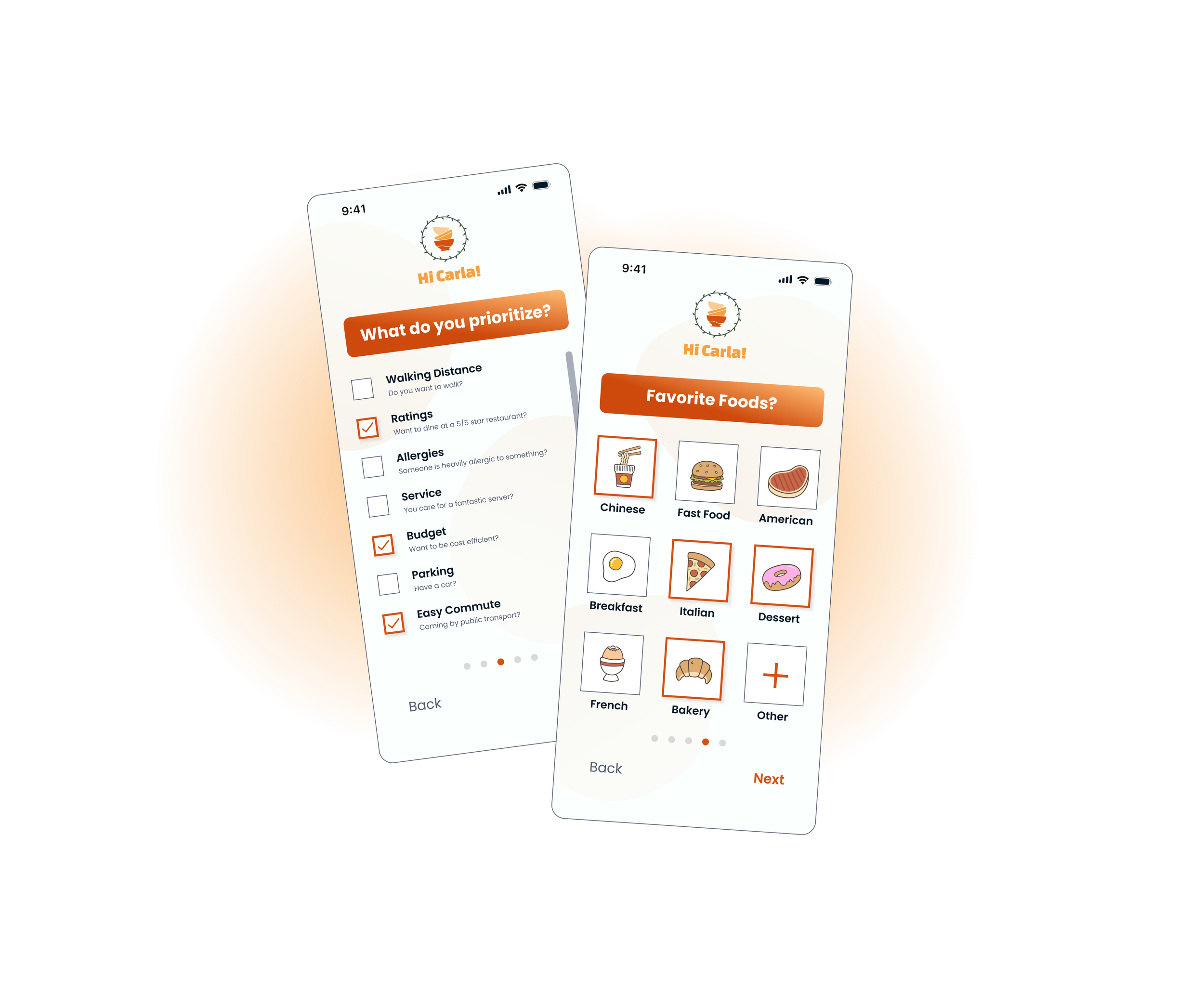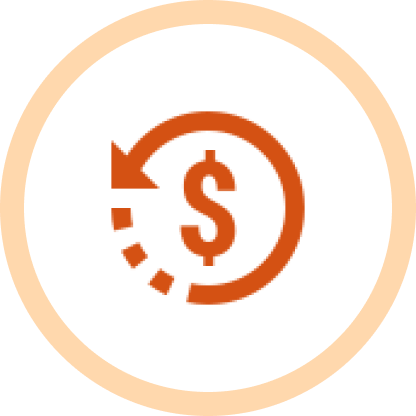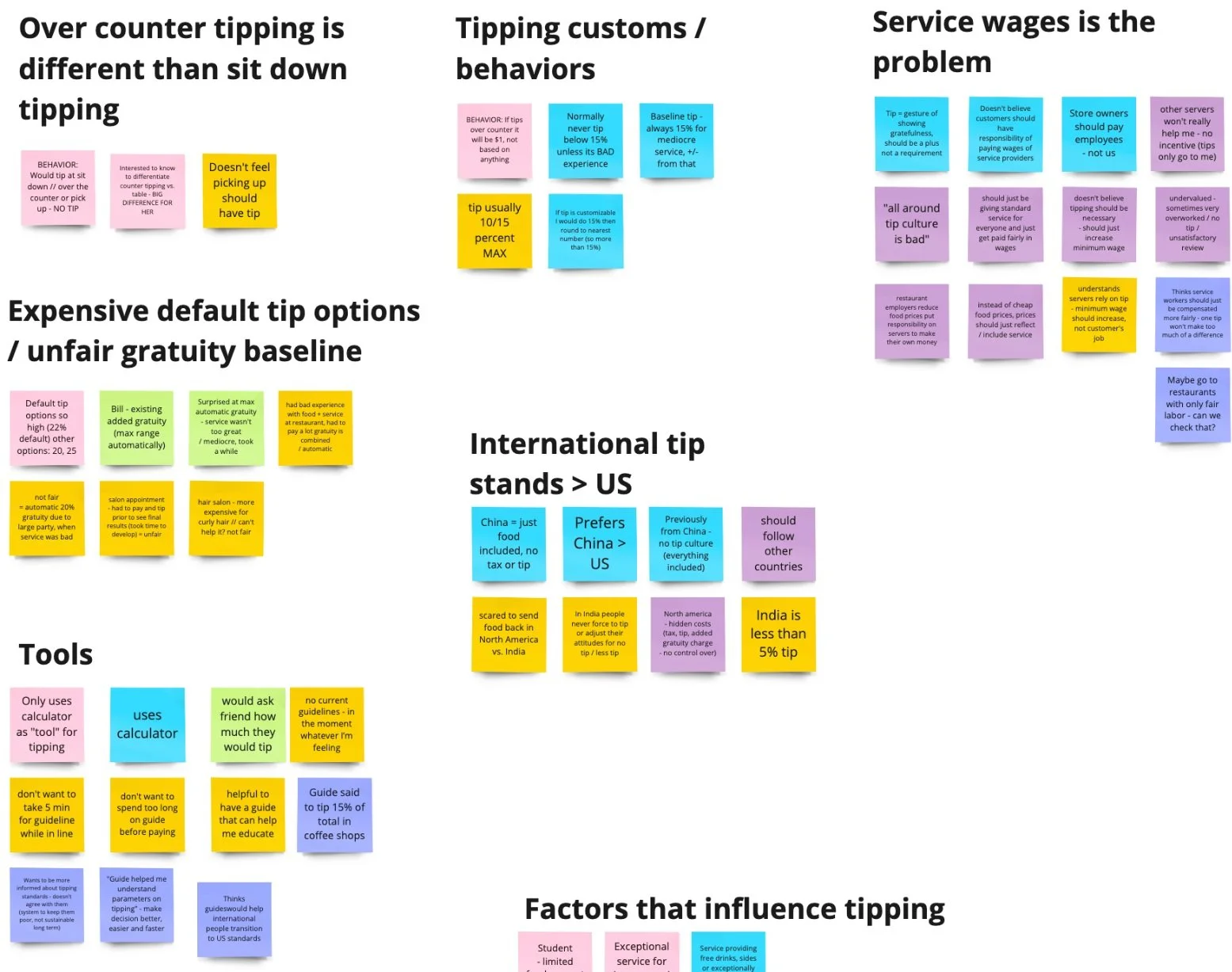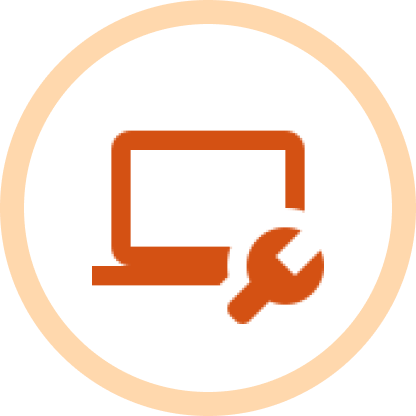NomsAway
Reduce decision fatigue, group conflict and find your “most-fit” restaurant!
Overview
Role & Team
I worked with 2 Product Managers & 1 UX/UI Designer. My role was Designer & Researcher.
Goal
Create a new service that streamlines group decision making processes and reduce fatigue.
What I did
Market & user research, UX/UI design, prototyping testing, team resolution, pitching.
What I delivered
PESTLE / POG, User personas, paper prototypes, wireframes, lo/mid/hi screens.
Get personal with your group restaurant suggestions!🍔
Filter and decide on a top restaurant choice with a group voting feature based on near by cuisines, type of food and user specific preferences for easy group decision making!
Process

Problem
The question of: “Where are we eating?” is a costly affair.
Did you know that 997 million minutes per year on average is spent on deciding where to eat? That translates to around 15 billion dollars as time = money! Especially when traveling in a foreign location, travel groups typically make last minute decisions in regards of food. Instead of enjoying their travels, they fixate, argue and stress!
“How might we facilitate on-the go group decision making while accounting for each members preferences and restrictions?”
Solution
On the go group decision making without the conflict!
💡Our project aim:
Reduce group conflict and decision fatigue by simplifying group decision making while satisfying needs and preferences of all members.
Quick & Informative On-Boarding Experience.
Hassle free registration
Brief overview & outline of app’s goals
Intuitive user graphics
Personalized character types
Understanding who they are traveling with
Traveling habits
Getting personal with the traveller.
Access to multiple recommendation sources.
Recommendations pulled from multiple sources.
Recommendations tailored to specific users.
Location tracking allows on-the-go recommendations
Intuitive, informative and condensed information about any location suggested
Get recommendations along the way.
Access to multiple recommendation sources.
Recommendations pulled from multiple sources.
Recommendations tailored to specific users.
Research
Through this project, we found the value of rapid research… this helped us pivot 3 different times!
Our first initial concept was called “Tip Wise” we are still exploring around the restaurant / food industry however it was more focused on the idea and social construct of eliminating “Guilt Tipping”. Rapid initial research was done through PESTLE / SET analysis.
Economical
Rising inflation caused a “cash crunch” in middle-class (72% consumers income short of spending)
CPI is on the incline at 6.5%; making everything unaffordable.
Sources: CBO Report 2023
Conducted sessions lead by participants including international students to hear about their personal experiences and interactions with tipping.
Took users (students) to service provider and had them order with online tip guide. Then documented / analysed specific behaviors.
Flow 1
Pivot 2:
New Target Users
Target audience are now travelers (travel / vacation based)
Information Overload
Location & Crowd-Source Service
MVP 2 is now location-based crowd source service that notifies the user
Flow 2
Not only Tipping
Not only tips - expanded to restaurants and all things uncertain (hidden expenses, must-haves/avoids, allergies, etc).
Flow 3
A new user flow is proposed, showcasing sample screens that integrates major changes to our service, based on previous insights.
Feedback is not engaging
To validate this new iteration, we utilized our sketches and flash cards to implement experience prototyping…
Experience prototyping helps to simulate a realistic environment while following our proposed screens. The goal is to test which specific information users want to see on the app when selecting restaurants. We ran tests through the following:
Insight
Guilt tipping is an “in-the-moment” niche problem, hence, they don’t want to pay for the service
Insight
Users don’t prefer pulling out an app and checking recommended tip, they feel more awkward.
Insight
Customers get accustomed to tipping uncertainties overtime and hence, don’t require a guide in the long term
Problem Scope too narrow
Technological
Point of Sales systems have pushed tipping prompts to consumers. This increased discomfort regarding tipping practices as it became on the spot and unavoidable.
Sources: The Motley Fool
We selected 2 major groups, firstly participants who are customers that suffer from “awkward” tipping practices and also people of the service industry. This allows us to have a perspective from the user receiving the service and the provider.
TipWise
Social
Americans tipped 16% more in 2022. 62% felt pressure to tip.
100k monthly Google searches of "How To's" and generic tipping guides.
Sources: CNBC 2022 survey, Google
Pivot 1:
TipWise- MVP 2
Based on findings and gaps from MVP 1 validation, we knew we had to pivot our idea and expand; tipping is too niche of a problem frame. In MVP 2, we also decided to pivot our target user and this opened an entirely new market and possibilities of features.
Insight
Too many features make it difficult to understand & reduces overall value
Insight
Pain point not big enough to make customers pay, difficulty to scale
Insight
Users don’t have incentive to provide feedback, creates friction in dining process.
Insight
Users can make do with existing solutions, no motivation to continue service
No value proposition
Time to PIVOT! 🚀
Based on the experience prototyping exercise, we knew focusing on “all things unexpected” is way too niche and narrow of a scope to generate value. It was time to expand scope to overall experiences around restaurant and food recommendations… that is a competitive market.
So, what will make our service different?
Ideation
From previous iterations, we found tipping or uncertainties about dining does not drive value!
For MVP 3, we decided to stick with our user segment of “travelers” and take a deeper dive into their problem space. To focus on solving their pain points, we decided to conduct some market research and implement a survey activity for validation.
35 participants, 13 importance factors based on researchSocial
Rising popularity for influencer driven tourism
Growing preferences for Local culture experiences
Economical
Tourists contributed 10% out of $899 billion total restaurant sales in the United States (2021)
Geotags help users identify local restaurants
New age tech used to boost market and sales
After conducting 35 individual surveys to rate 13 factors based on importance and satisfaction, restaurant recommendations & ease of access emerged as top opportunities.
This became the new focus and pain paint to solve for NomsAway.
Technological
Opportunity
Finding food during travels
Target User
Leisure travelers on-the-go
Group Travel
77% group travel in USA
After market analysis and secondary research, we conducted 20 user interviews to validate the research captured and NomsAway as an idea.
Goal is to understand travel…✈️
Travel habits & decision making
Ways of planning
Group vs. Solo travel
& food planning processes…🍔
Major considerations of decision-making
Food / restaurant preferences
Major concerns while planning for food during travel
Food = Spontaneous
Validate Group travel
Insight
Importance of Food
Food was rated very important (4.1 / 5) to travel experience
Insight
>90% users prefer to travel in groups instead of solo for leisure trips
Insight
80% users don’t pre-plan food for trips
Insight
Reaching consensus and finding itinerary friendly restaurant are top concerns
To move from concept to confirmation, we developed interactive prototypes and conducted user testing to validate our core assumptions.
The Cost of Consensus
























































